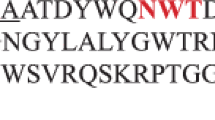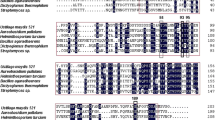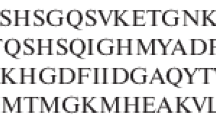Abstract
A xylanase-encoding gene, xyn11F63, was isolated from Penicillium sp. F63 CGMCC1669 using degenerated polymerase chain reaction (PCR) and thermal asymmetric interlaced (TAIL)-PCR techniques. The full-length chromosomal gene consists of 724 bp, including a 73-bp intron, and encodes a 217 amino acid polypeptide. The deduced amino acid sequence of xyn11F63 shows the highest identity of 70% to the xylanase from Penicillium sp. strain 40, which belongs to glycosyl hydrolases family 11. The gene was overexpressed in Pichia pastoris, and its activity in the culture medium reached 516 U ml−1. After purification to electrophoretic homogeneity, the enzyme showed maximal activity at pH 4.5 and 40°C, was stable at acidic buffers of pH 4.5–9.0, and was resistant to proteases (proteinase K, trypsin, subtilisin A, and α-chymotrypsin). The specific activity, K m, and V max for oat spelt xylan substrate was 7,988 U mg−1, 22.2 mg ml−1, and 15,105.7 μmol min−1 mg−1, respectively. These properties make XYN11F63 a potential economical candidate for use in feed and food industrial applications.



Similar content being viewed by others
References
Polizeli, M., Rizzatti, A., Monti, R., Terenzi, H., Jorge, J., & Amorim, D. (2005). Applied Microbiology and Biotechnology, 67, 577–591.
Collins, T., Gerday, C., & Feller, G. (2005). FEMS Microbiology Reviews, 29, 3–23.
Chávez, R., Bull, P., & Eyzaguirre, J. (2006). Journal of Biotechnology, 123, 413–433.
Viikari, L., Kantelinen, A., Sundquist, J., & Linko, M. (1994). FEMS Microbiology Reviews, 13, 335–350.
Jeffries, T. (1996). Current Opinion in Biotechnology, 7, 337–342.
Haltrich, D., Nidetzky, B., Kulbe, K., Steiner, W., & Zupancic, S. (1996). Bioresource Technology, 58, 137–162.
Tanaka, H., Nakamura, T., Hayashi, S., & Ohta, K. (2005). Journal of Bioscience and Bioengineering, 100, 623–630.
Furniss, C., Belshaw, N., Alcocer, M., Williamson, G., Elliott, G., Gebruers, K., et al. (2002). Biochimica et Biophysica Acta: Proteins and Proteomics, 1598, 24–29.
Kimura, T., Ito, J., Kawano, A., Makino, T., Kondo, H., Karita, S., et al. (2000). Bioscience, Biotechnology, and Biochemistry, 64, 1230–1237.
Diaz, R., Sapag, A., Peirano, A., Steiner, J., & Eyzaguirre, J. (1997). Gene, 187, 247–251.
Milagres, A., & Prade, R. (1994). Enzyme and Microbial Technology, 16, 627–632.
Mandels, M., & Weber, J. (1969). Advances in Chemistry Series, 95, 391–414.
Sambrook, J., Fritsch, E. F., & Maniatis, T. (1989). Molecular cloning, a laboratory manual. New York: Cold Spring Harbor Laboratory Press.
Liu, Y., & Whittier, R. (1995). Genomics, 25, 674–681.
Laemmli, U. (1970). Nature, 227, 680–685.
Bradford, M. (1976). Analytical Biochemistry, 72, 248–254.
Miller, G. (1959). Analytical Chemistry, 31, 426–428.
Yang, P., Shi, P., Wang, Y., Bai, Y., Meng, K., Luo, H., et al. (2007). Journal of Microbiology and Biotechnology, 17, 58–66.
Cereghino, J., & Cregg, J. (2000). FEMS Microbiology Reviews, 24, 45–66.
Knob, A., & Carmona, E. (2008). World Applied Sciences Journal, 4, 277–283.
Mi, S., Meng, K., Wang, Y., Bai, Y., Yuan, T., Luo, H., et al. (2006). Enzyme and Microbial Technology, 40, 1373–1380.
Ryan, S., Nolan, K., Thompson, R., Gubitz, G., Savage, A., & Tuohy, M. (2003). Enzyme and Microbial Technology, 33, 775–785.
Ito, K., Iwashita, K., & Iwano, K. (1992). Bioscience, Biotechnology, and Biochemistry, 56, 1338–1340.
Kinoshita, K., Takano, M., Koseki, T., Ito, K., & Iwano, K. (1995). Journal of Fermentation and Bioengineering, 79, 422–428.
Krengel, U., & Dijkstra, B. (1996). Journal of Molecular Biology, 263, 70–78.
Marinsek-Logar, A. G., Martin, J., Wallace, R. J., Nekrep, F. V., & Flint, H. J. (1995). FEMS Microbiology Letters, 125, 135–142.
Acknowledgements
This work was supported by the Chinese National High Technology Research and Development Program (863 Program, Grant No. 2007AA100601) and the Chinese Agricultural Microorganism Collection and Share Program (No. 2005DKA21201).
Author information
Authors and Affiliations
Corresponding author
Rights and permissions
About this article
Cite this article
Liu, W., Shi, P., Chen, Q. et al. Gene Cloning, Overexpression, and Characterization of a Xylanase from Penicillium sp. CGMCC 1669. Appl Biochem Biotechnol 162, 1–12 (2010). https://doi.org/10.1007/s12010-009-8719-4
Received:
Accepted:
Published:
Issue Date:
DOI: https://doi.org/10.1007/s12010-009-8719-4




